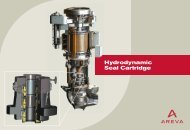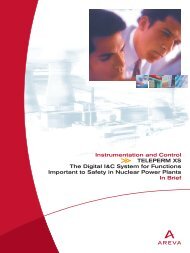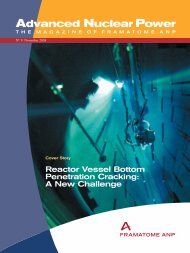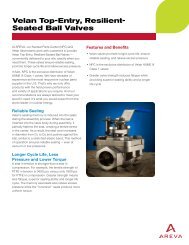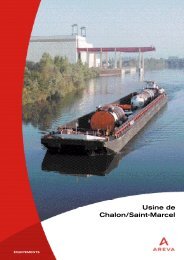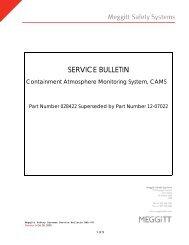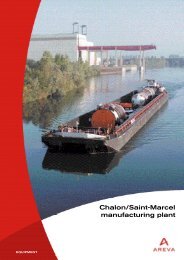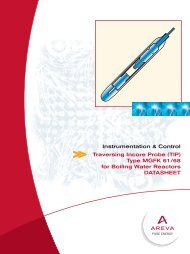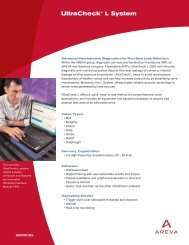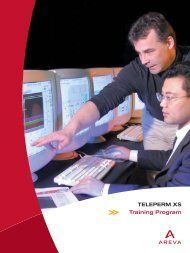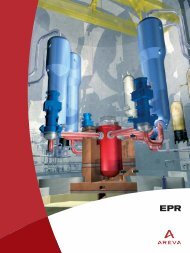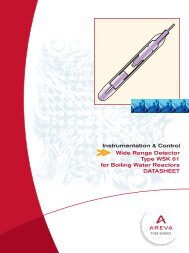You also want an ePaper? Increase the reach of your titles
YUMPU automatically turns print PDFs into web optimized ePapers that Google loves.
C O N T E N T SAdvanced Nuclear PowerN O 7 April 20033 Perspective<strong>Framatome</strong> <strong>ANP</strong>Worldwide OfficesTour <strong>AREVA</strong>92084 Paris La Défense CedexFranceTel: +33 1 47 96 00 00Fax: +33 1 47 96 36 36FRinfo@framatome-anp.com3315 Old Forest RoadLynchburg, VA 24501USATel: +1 434 832 3000Fax: +1 434 832 0622USinfo@framatome-anp.comFreyeslebenstr. 191058 ErlangenGermanyTel: +49 9131 18 95374Fax: +49 9131 18 94927DEinfo@framatome-anp.comEDITORIAL STAFFPublisherNicolas BrunEditor-in-ChiefSusan HessManaging EditorMartha WieseRegional EditorsChristine FischerCatherine RouetPhilippe RouillerMartha WieseGraphic DesignThe O’Connor Group/Tim BassfordContributing WritersFranz Ammann, Jean-Paul Bombail,Alice Clamp, Carl Crawford,Gérald Doucet, Christine Fischer,Peter Hümpfner, Dan Keuter,Klaus Knecht, Bruno Marchal,Martha Wiese.External writers’ articles expressthe opinion and views of the authorbut may not reflect the positionof <strong>Framatome</strong> <strong>ANP</strong>.Industry Insights4 Nuclear Power and Sustainable Development6 Nuclear Generated Hydrogen:A Win/Win SituationCover Story8 Standardized Outage Process Improves PerformanceFeatures12 Future French Energy Mix: A National Debate13 Flying RV Head Meets Tight Schedule14 Oskarshamn 1: Fit for Another 20 years15 SIPPING16: BWR Fuel Inspectionin World Record Time16 Adhesive Bonding TechniqueUsed for Preventative Maintenance at IkataInnovation & Technology19 Specially Designed Plug Saves Critical Path Time20 The GAIA Project: Meeting the Needs of the Future21 Depleted Zinc: A Proactive Solution to Dose ConcernsDepartments18 News In Brief22 Equipment & Services23 ContractsCover: Two technicians preparing for outage work.M5 is a trademark of Fragema, a wholly ownedsubsidiary of <strong>Framatome</strong> <strong>ANP</strong>.
Industry InsightsNuclear Power and SustainableThe World Energy Council(WEC) is the leading global,multi-energy organization, withnational member committees in 96countries worldwide. WEC covers allforms of energy, including coal, oil,natural gas, nuclear, hydro and otherrenewables. Its mission is to promotethe sustainable supply and use ofenergy for the greatest benefit of all.Through a wide range of publications,programs and activities, WEC workstoward influencing energy policy andpractice in a global, multi-energycontext and increasing understandingof key energy issues nationally, regionallyand globally. For more informationabout the World Energy Council, visitthe website at www.worldenergy.org.At last September’s World Summiton Sustainable Development inJohannesburg, a key theme wasbalancing the eradication of povertywith the fundamental need forsustainable development. Unlike Rioten years ago, almost no one inJohannesburg was buying the earlydemise of fossil fuels or nuclear powerin the world’s energy mix. Certainnon-government organizations madetheir disappointment known, but theywere admonished by the developingcountries themselves, where twobillion people do not have access toany commercial energy, resulting ingreat risk to their health, human rightsand the environment.The focus in Johannesburg was lesson the environment and more onsuch key issues as access to commercialenergy as part of a global effortto eradicate poverty. This echoesWEC’s long-standing emphasis onthe importance of achieving accessto commercial energy for those whodo not now have it. To achieve thisgoal, WEC sees the following asnecessary actions:• Keeping all energy options open(including the safe use of nuclearpower and the promotion ofrenewables)• Market reform• Developing stable regional tradepolicies, clear legal frameworksand sensible regulations forenergy development• Increasing efficiency throughcompetition and technologydiffusion• Implementing advanced, cleanertechnologies to reduce the impactof human-induced emissions onthe quality of human life and thenatural world around usThese goals are closely related. Tradeand technology drive economicgrowth, which is the prerequisite foraddressing poverty and access to energy.This in turn is closely linked to energyavailability and energy acceptability.WEC believes that acting now toachieve these goals will contribute toa reduction in political tensions andpromote greater harmony in the world.While many poor continue to livein rural areas, most of the nexttwo billion people to be born indeveloping countries will likely livein cities. Nuclear must be part of thesolution to their energy demands andenvironmental problems. But to befully successful, nuclear must bewidely accepted by society. This meansthat governments should play anactive role, educating society not onlyabout nuclear waste but also aboutCO 2 and other emissions. Electricityconsumers who have the choicemust start comparing the risks of alltechnologies. Politicians should initiatedebate, assist countries whose reactorsare unsafe and ensure a level playingfield in the energy market. Andthe nuclear industry must becomeresponsible for itself – more transparent,independent and able to show throughits long-term calculation of economicand safety performance that it cansurvive in the marketplaceOf course, if fossil fuel prices rise inthe shorter term – either because ofthe cost of new, cleaner technologiesMr. Doucet, a Canadian, became Secretary Generalof the World Energy Council in 1998. The work ofthe World Energy Council, a global organizationestablished in London in 1923 with over 90 membercountries, embraces a broad range of energy issuesincluding energy scenarios, energy marketstructures, environment and energy poverty.4 Advanced Nuclear Power N O 7 April 2003
Perspective1Shorter OutagesAre Good Business1322Over the last decade, operating a nuclearpower plant has undergone major changes.Deregulation has increased competition andoperators have successfully streamlined their operationsto reduce costs and maximize output. Increased attentionhas been paid to safe operations and the conceptof extending the lifetime of the plants has precipitatedin-depth analyses of components and upgrading systems.In their efforts to improve plant operations, more andmore utilities are forming partnering-type alliances. These long-termrelationships allow both the operator and the vendor to focus on the samegoals, provide experienced working teams that lead to continuous improvementin operations through better resource utilization and planning and result ina win/win situation for both parties and also cost reductions.In particular, outage optimization has attracted increasing attention. A decadeago, it was not unusual for outages to last 40 to 60 days. Today, they rangefrom the teens to the 20s, with some in Europe as low as 6 – 8 days. Obviously,the longer a plant can run without interruption, the higher the capacity factorsand the greater the potential for higher revenues.A new term - outage optimization - has been coined in recent years. As thename implies, it is intended to cover more than just managing an outage.It involves both long and short-term planning and detailed analysis of everyaspect of plant operation so that each scheduled outage accomplishes the mostimportant tasks in a logical and carefully determined order while reducingthe risk of unscheduled shutdowns. Reducing outage durations enhancesplant availability, reduces costs and ensures that a utility remains competitivewhile enhancing quality and safety.Wulf BürkleSenior ExecutiveVice President<strong>Framatome</strong> <strong>ANP</strong>
DevelopmentGerald Doucetor because of regulations to internalizeCO 2 and emissions waste managementcosts in the price of energy servicesbased on fossil fuels – nuclear powercould benefit, in relative terms.Growing awareness of rationalcriteria regarding the economics,security/reliability and environmentalperformance favor nuclear’s significantrebirth when present power plants arereplaced in the 2010-20 period.It is a foregone conclusion that up to2020, global reliance on fossil fuelsand large hydro will remain strong,albeit with special emphasis on therole of natural gas and efficient,cleaner fossil fuel systems. However,total reliance on these energy sourcesto satisfy the growing electricitydemand is not sustainable. Whilesome question the future of nuclearpower, many believe its role needsto be stabilized, with the aim ofpossible future extensions, and thatefforts to develop intrinsically safe,affordable nuclear technology needto be encouraged.WEC’s research and global studieslead us to believe that nuclear energywill play an essential role in electricityproduction and in strategies againstglobal warming. For base-load electricitygeneration, one of the most effectivemeans currently available to reduceCO 2 emissions is nuclear power.Countries with the highest proportionof nuclear and/or hydropower havethe lowest CO 2 emissions per kWh.Nuclear energy has advantages interms of global warming, cost stabilityand high capacity factors that make itcompatible with the goals of sustainabledevelopment for tomorrow’s world.WEC continues to address theseand other key energy issues throughour Work Program. Our study on“Drivers of the Energy Scene,”dueout later this year, will guide fourother WEC studies on market reform,technologies, life cycle analysis andclimate change to be published in2004. WEC also carries out a seriesof six technical services, includingpower plant performance andour GHG Emissions ReductionsDatabase, with nearly 1.96 Gt ofcurrent total emissions reductionstored in the database. For moreinformation, visit our GlobalEnergy Information System atwww.worldenergy.org. ■Advanced Nuclear Power N O 7 April 2003 5
Industry InsightsNuclear Generated Hydrogen:A Win/Win SituationDan KeuterIceland has resolved to become theworld’s first economy running entirelyon hydrogen, instead of oil or naturalgas. The President of the EuropeanCommission, the governing body of theEuropean Union, says the EU will spend$2 billion (€1,870,000) to develop ahydrogen future. The US Department ofEnergy is giving millions of dollars to theautomotive industry to develop a fuel cellfor cars. President Bush, in his State ofthe Union address to the US Congress inJanuary, called for “the first car driven bya child born today to be a hydrogen carthat does not pollute the air.”Demand for H2 Growing RapidlyLiquid fuel production is rapidlybecoming major market for H2> 10%/yr*Refining @ ~10% per year growth• X2 current demand by 2010• X4 current demand by 2017That’s huge!*(SSB, DOE, & Industry Sources)Background: Hydrogen, 3D VisualizationThe question is –Where is all thathydrogen coming from? The onlypractical way to produce large volumesof emission-free hydrogen is fromadvanced nuclear reactors.Hydrogen TodayThe current world consumption ofhydrogen is about 40 million tons ayear, 11 million of which is used inthe US. Most hydrogen today isproduced by breaking down naturalgas (methane). But in the steamreformation process, to produce that11 million tons, 74 million tons ofcarbon dioxide is released to theatmosphere every year, worsening thegreenhouse climate change problem.That’s seven tons of pollutants foreach ton of hydrogen.About a third of hydrogen today isused to make ammonia fertilizer forfarms, a third is used in oil refiningto make cleaner gasoline (a growingdemand since the world’s oilrefineries are having to use moreheavy sour crude oil for the lack oflight sweet crude), and a third usedto make methanol, merchant gasand other products.So the more hydrogen made fromnatural gas, the more we are justexchanging one problem (increasingdependence on oil, worsening urban airpollution, Middle East geopolitics) foranother (climate change, increasingdependence on natural gas).The fact is a hydrogen economy onlymakes sense if you have a non-emittingsource of hydrogen. That means usingrenewable energy and nuclear.Renewable Energy forHydrogen ProductionTo generate the equivalent of a typicalnuclear reactor (1,000 megawatts)would require 100 km 2 or 40 squaremiles of photovoltaic solar panels,3,000 windmill turbines at 1,000 kWeach covering 40-70 square miles,30,000 km 2 or 12,000 square miles offorest for wood biomass, 60 millionpigs or 800 million chickens for biogas.By comparison, a nuclear power unitrequires about one square kilometer ora third of a square mile of land area.That is just the land area required.It does not address the questionof whether those renewable energysources can be developed at areasonable cost, nor the lengthof time required for developmentand construction.The truth is the global task of reducinggreenhouse gas at a reasonable costis impossible without building newnuclear power plants. Nuclear is theonly economical source of energy thatdoes not emit carbon dioxide, the chiefgreenhouse gas.The good news is advanced reactorscan do both – produce large volumesof hydrogen at low cost and do itwithout emitting any greenhouse gasor other air pollution (sulfur dioxide,nitrogen oxide or mercury).The FutureEven without whole economies(Iceland, EU, USA) trying to switchfrom oil/gas to hydrogen, the marketdemand for hydrogen is alreadygrowing by 10 percent a year, andis forecast to double by 2010 andquadruple by 2017. That’s huge,6 Advanced Nuclear Power N O 7 April 2003
and that’s mostly hydrogen demandto make cleaner gasoline and relatedliquid fuels, i.e., to sustain thestatus quo.Advanced gas reactors will take 10years to develop too, but the payoffis much bigger.World Consumption of H2 > 40M Tons/Yr.U.S. Consumption > 11M Tons/Yr. (48 GWth)• ~96% produced by steam methane reforming• Consumes 5% of our natural gas• Release 74 M tons of CO2/yrFor example, they are cooled withhelium, an inert, non-corrosive gas withsignificantly less contamination, unlikethe water circulating in today’s lightwater reactors. Second, they can bebuilt underground, making themterrorist hardened. They would bevirtually meltdown proof because oftheir physics. When they get too hot,the chain reaction stops automaticallyand the decay heat dissipates intothe ground around the plant. Noemergency plan beyond the plant’sfence is needed.But the most compelling advantage isthat, like all nuclear energy plants, thereare no air pollutants such as SO2,NOX, mercury or CO2. They alsowould reduce dependence on foreignoil and gas, reducing the world’sdependence on the unstable MiddleEast. And a hydrogen infrastructurewould be a great “battery” for whateversolar and wind power exists by storingtheir energy whenever the sun shines orthe wind blows.Farfetched? Yes, a transition to ahydrogen economy would take years.The good news is advanced nuclearenergy reactors lend themselves to aneasy, gradual transition.For example, today’s gasoline pumpscould be replaced with electrolysisunits, running on electricity and waterand making hydrogen at the stationto put in cars. Electrolysis unitsthemselves have an efficiencyapproaching 80 percent but an overallsystem efficiency of 25-40 percent,compared to the 33-50 percentefficiency of today’s electric system.The implementation could bestaged over time as the numberof hydrogen cars grows.Later advanced reactors which operateat 850-950ºC (1,562 -1,742ºF),compared to today’s light water reactoroperating at 315ºC (599ºF), are hotenough to split water into hydrogenand oxygen in a process calledthermo-chemical splitting. Suchreactors would reach 50 percentefficiency. For the first time, hydrogenwould be created in very large volumesat low cost that could be piped totoday’s gas filling stations.The unique combination of nuclearenergy and hydrogen can solve severalissues at once – energy security anddiversity, clean air, and reducedclimate change. ■Dan Keuter, Vice President of Nuclear Development, EntergyNuclear in Jackson, Mississippi, has been instrumental in growingEntergy Nuclear to its current position as the second largestoperator of nuclear power plants in the US. As Chairman ofthe Utility Advisory Board for an advanced gas-cooled reactor,he has been a strong advocate for the clean generationof hydrogen using nuclear power plants.Advanced Nuclear Power N O 7 April 2003 7
Cover StoryStandardized OutageOver the last several years,leading plant operators havedemonstrated that availability factorscan be improved, operating costsreduced, and safety and reliabilityenhanced on a long-term basis. Outageoptimization is a new term being usedto describe these long-term initiatives.A variety of measures aimed atshortening scheduled plant outageshave been developed and successfullyimplemented by these leaders workingwith their service providers whointroduced new technologies andprocess improvementsNew <strong>Framatome</strong> <strong>ANP</strong> IVVI bridge installed with refueling bridge atBrowns Ferry allows simultaneous inspection and refueling work.All nuclear plant operators now haveambitious outage optimization plans,and the median and average outagedurations are decreasing on a worldwidebasis. The high economical impact ofoutage time reduction is impressivelyillustrated by the fact that in the last tenyears in the US, an additional poweroutput equivalent to ten 1000MWeNuclear Power Plants (NPP) has beenachieved through outage durationreductions – without investing in newplants and without additional plantpersonnel. Future objectives are evenmore aggressive and must include plantupgrades and component replacementsbeing performed for life extension ofplant operation.Outage optimization covers a broadrange of activities from modificationsof plant systems to faster cool downrates to human behavior improvements.It has been proven to reduce costsand radiation doses, avoid unplannedoutages and thus support plantavailability and help to ensure the utility’scompetitive position in the marketplace.The Concept<strong>Framatome</strong> <strong>ANP</strong>, aware of thestrategic importance of its customers’8 Advanced Nuclear Power N O 7 April 2003
ProcessImproves Performancegoals of reducing outage durations,has created an Outage OptimizationProject Team that spans all regions andbusiness groups of the company. Theconcept behind the project is that:• plant operators drive the outageduration reduction goals• customers benefit from <strong>Framatome</strong><strong>ANP</strong>’s unique ability to gather andshare “best practices” experience on aworldwide basis• although there is not a single, standaloneoutage optimization product orprogram that fits every customer andplant, a process can be developed toensure that every aspect of an outageis analyzed and evaluated. In thisway, all opportunities for reducingoutages are identified to allowdecisions based on solid data• quality, safety and costs have to bedriven simultaneouslyBecause outage optimization is soimportant to <strong>Framatome</strong> <strong>ANP</strong>’scustomers, team members developedan Outage Optimization Handbookthat identifies and defines all theactivities performed during a typicaloutage. To identify potential sources ofgains, the team performs extensiveWindow and GAP analysis for alltypes of PWR and BWR designs.Further to these analyses, lookingglobally at an outage, its preparationand its experience feedback, the teamalso performs micro gap analysisfocused on specific outage phaseswhere <strong>Framatome</strong> <strong>ANP</strong> teams areregularly involved. A series ofprocesses, covering anything thatcan impact an outage, has beendeveloped to ensure that all sourcesof gains have been analyzed. Inaddition, the team examines thosemaintenance activities that can beperformed during normal operations.Advanced Nuclear Power N O 7 April 2003 9
Cover StoryStandardized Outage ProcessImprovesFour-PartAnalysis SystemThe window and GAP analyses helpthe team identify the main constraintsand source of delays that impact anoutage. To ensure that everything thatcan affect an outage has beeninvestigated, the team developed afour-part analysis system to identifyand implement improvements thatmove an organization to higherperformance:A. Soft Skills – planning, scheduling,communications, ownership, scopecontrol, task management, longtermoutage strategy – all thoseitems that are human behaviordriven, nearly free of cost, but arepresent in every successful outageorganization in the world.B. Specific Task Improvements –refueling, steam generator, pumpand motor, valve maintenance –those typical areas that have alwaysbeen the domain of the servicevendor to bring advanced tooling,robotics, and skilled personnel toperform specific tasks usuallyconfined to outages.C. System EngineeringImprovements – technicalspecifications, faster cool downrates, water management plans,chemistry, license changes, andreliability-centered maintenancepractices, all applied to shortenoutage windows or eliminateoutage tasks.D. Major Modifications to plantsystems, structures or componentsto shorten outage durations.Integrated head packages forUS PWRs, permanent cavityseal plates, upgraded fuelhandling bridge control systems,and single pass stud tensioningcarousels are examples ofavailable improvements.Improvements in outage duration areobtained through a benchmark andgap analysis process where the plantand the outage team work together toassess the best performances andpractices already in place, comparecurrent plans to those best practices,establish the individual site’s risk andfinancial restrictions, and thenimplement selected improvements thatsatisfy the plant’s needs withoutexceeding their financial limitations.Thus, the final solution varies fromplant to plant. Every outage is anindividual event.Outage OptimizationGermany has been a worldwide leaderin this area. They initiated an outageoptimization process in the beginningof the 90s and achieved outages asshort as seven days. To reduce outagesfrom more than 30 days down toseven and increase plant availability,plant operators developed long-termoutage strategies, focused on outageplanning and management, andestablished a production-orientedmaintenance strategy. <strong>Framatome</strong><strong>ANP</strong> cooperated on the overallplanning, especially on critical pathactivities, optimized personelresources, and developed innovativetechnologies and tools.Another example of this type of workalready underway is the Sizewell Bplant in England. Framtome <strong>ANP</strong> ispart of a consortium that has alreadyhelped Sizewell reduce its lastperformed outage by 16 days. Toaccomplish this, an Outage ControlCenter was created along with a HighImpact team to optimize outagepreparation and performance.Electricité de France (EDF) haslaunched an ambitious outageoptimization program whilemaintaining its high safety standards.<strong>Framatome</strong> <strong>ANP</strong> is developing servicepackage concepts (B) for some plantsas well as working on severalengineering issues (C) for tasks oncritical path (or near critical) such asspecific periodic test or operationsconstraints at other plants.In addition, <strong>Framatome</strong> <strong>ANP</strong> providesoutage optimization consulting andplant evaluation services, plant toolingupgrades including intelligentdiagnostic systems, system engineering10 Advanced Nuclear Power N O 7 April 2003
Performance (continued)A: Outage managementsupport/Soft SkillsB: Specific taskimprovementsOutage execution &tooling<strong>Framatome</strong> <strong>ANP</strong>ExperienceFeedback (US, Ger, F)• Windows & GAPanalysis• Best practices(Data Base)C: System engineeringimprovementD: Modification andupgradingand licensing services to optimizeoutage performance, and optimizationmodifications to plant structure,systems or components.In the US, as part of several outages,permanent canal seal plates andintegrated head assemblies are beinginstalled to reduce disassembly andreassembly times. These are examplesof major modifications that can have apositive impact, over the long-term,on outage duration.Steve Huntington, US Vice President,Outage and NDE Servicescommented, “By forming a dedicatedOutage Optimization Project Teamthat unites the outage services,engineering and project managementfunctions across the entire company,<strong>Framatome</strong> <strong>ANP</strong> offers its customersmore than just outage services. Byworking together with the customer,the company examines every aspect ofplant operation from every perspectiveto minimize unplanned outagesthrough long-term plans for scheduledmaintenance, repair and componentreplacement, if needed. This approach,combined with targeted efforts toreduce outage durations, results in thehighest and safest performancepossible for <strong>Framatome</strong> <strong>ANP</strong>’scustomers plants.” ■Advanced Nuclear Power N O 7 April 2003 11
FeaturesFuture French Energy Mix:A National DebateThe French Government hasinitiated a public debate onenergy that will involve the Frenchpopulation in a discussion of the mainenergy choices for France over the nextthirty years, i.e. discussion on issuessuch as managing security and energyprovision, nuclear and renewableenergy sources.The debate will take place duringthe first six months of 2003 and willbe led by the French Deputy Ministerfor Industry, working in partnershipwith the French Ministers for Ecologyand Sustainable Development, Works,Transport, Housing, and Youth andNational Education.To ensure a pluralistic approach,the Government has enlisted the aidof a committee of experts consistingof a sociologist-philosopher, thefounder and former president of theFrench Academy of Technologies,and a scientific journalist who willmake sure the debate is pluralisticand balanced: a consultationcommittee consisting mainly ofmembers of Parliament and civilrepresentatives will be in charge ofcommunicating this debate to allelected French representatives.The national debate will target thegeneral public with a special emphasison the involvement of young people.Open discussions will be held in sixmajor regions and cities, a dedicatedwebsite is already available atwww.debat-energie.gouv.fr, andassociations and organizations arebeing invited to participate, providingthey comply with a partnershipcharter based on openness andplurality for a quality debate.This national debate is the startingpoint in preparing for the futurein several areas of daily life for theFrench population, and for initiatingan ongoing dialog on energy issues.The conclusions of the debate willbe used to draw up a General PolicyAct on Energy Sources that theGovernment will bring beforeParliament in 2003. ■This debate, the first organizedin France on a topic thathas been perceived, for a longtime, as sensitive and to bediscussed only behind closeddoors, has two main objectives:• Respond to an overwhelmingdesire for information fromthe French population, seventypercent of which feel they arebadly informed on energy issuesand want clearer explanationsand more transparency inenergy choices• Widen the scope of thecitizen consultation processand place it upstream of thedecision-making process forstrategic choices on France’senergy policy over the nextthree decades.12 Advanced Nuclear Power N O 7 April 2003
Flying RV Head MeetsTight Schedule1. The Russian-operatedAntonov 124 arrived inRichmond, Virginia, USA,shortly after 1 a.m. onDecember 17, 2002 with thenew reactor vessel headbound for DominionEnergy’s North Anna Unit 2nuclear power station.122. A system of cablesattached to a skid steadiesthe vessel head as it slowlymoves along rails extendingfrom the Antonov’s cargobay. A crew of some 25technicians and engineersfrom 3 countries worked asa team to remove the vesselhead from the Antonov.3. The vessel head movesslowly beneath the raisednose cone of the Antonov,capable of carrying up to132 tons.344. The heavy duty cranecarefully swings into positionto receive its payload once ithas cleared the Antonov.Every movement of the vesselhead from cargo bay toground transport wasmethodical and required morethan five hours to complete.5. Once clear of the Antonov,the crane hoists the 72.5ton vessel head into positionabove the ground transport.566. The vessel head is securedonto the transport for the finalleg of its journey to NorthAnna nuclear power stationabout 50 miles away nearLouisa, Virginia. It made thejourney at night to avoid tyingup traffic.Advanced Nuclear Power N O 7 April 2003 13
FeaturesOskarshamn 1:Fit for Another 20 YearsOskarshamn 1Nuclear Power Station.At Sweden’s oldest nuclearpower plant, Oskarshamn 1(475 MWe), an extensive “MOD”modernization program wascompleted recently, enablingthe 30-year-old BWR unit tooperate economically for at leastanother 20 years.Concept Developedby <strong>Framatome</strong> <strong>ANP</strong>The goals of the modernizationprogram originally defined in 1996 –namely, to extensively upgradeOskarshamn 1 and thereby enhanceplant safety – were implemented withgreat success. <strong>Framatome</strong> <strong>ANP</strong>developed a modernization conceptwhose key features included strictphysical separation of redundantsubsystems, greater diversity ofequipment design, and independenceof safety systems from those used fornormal plant operation. Theseconcepts were accepted, withoutchanges, by the Swedish licenseauthority and the operator. The workincluded the design and installation ofa brand new two-train low-pressureemergency core cooling system(ECCS) and modifications to thehigh-pressure system for emergencycore cooling to ensure consistentseparation of the redundant trains aswell as independence from the nonsafetysystems. In the future, four newbypass valves installed in parallel withthe existing safety-relief valves willguarantee not only safe and reliabledepressurization of the reactor but alsodiversity of equipment design for thereactor pressure limitation function.Implementation of the new safetyconcept additionally requiredinstallation of new emergency powerswitchgear along with two newemergency diesel generators plus acompletely new four-channel reactorprotection system, provided by adifferent vendor based on <strong>Framatome</strong><strong>ANP</strong>’s specifications.Large Scope of SupplyIn addition to the various systemupgrades, <strong>Framatome</strong> <strong>ANP</strong>’s scopeof supply also included design anderection of a new emergency controlbuilding to accommodate parts ofthe new ECCS, the new reactorprotection system, the new emergencypower switchgear and two newemergency diesels. The actual work onsite took around 13 months tocomplete. Despite the fact that anadditional order for backfitting a largepipe whip restraint – received shortlybefore the scheduled restart of theplant in November 2002 – led topostponement of the original restartdate, <strong>Framatome</strong> <strong>ANP</strong>’s on-sitepersonnel worked nights andweekends to ensure a return tocriticality by Christmas 2002,getting the plant back on line byJanuary 2, 2003.<strong>Framatome</strong> <strong>ANP</strong>’s successful planningand execution of the Oskarshamn 1modernization program furtherillustrates its extensive expertisefor complex backfitting andmodernization tasks. More than120 engineers from variousengineering disciplines were involvedin the project, with team and projectmanagers being supported bystate-of-the-art project managementtools and techniques.Oskarshamn 1: A MajorEnergy SupplierOskarshamn 1 plays a major rolein meeting the current high demandfor electricity in Sweden and theinterconnected Nordic power system.Extremely low temperatures in theregion this winter created ademand for power that could notbe met by hydropower plants dueto below-average precipitationin the summer and fall of 2002. ■Commissioning of new ECCS14 Advanced Nuclear Power N O 7 April 2003
SIPPING16: BWR Fuel Inspectionin World Record TimeThe SIPPING16 system developedby <strong>Framatome</strong> <strong>ANP</strong> in Germanyfor detecting leaking fuel in BWR coreshas now been deployed with greatsuccess at three German nuclear powerplant units. Measurements of reactorcoolant activity levels following thesipping tests at these plants verifiedthat all fuel assemblies containing fuelleakers had been identified bySIPPING16, thus confirming thesystem’s excellent reliability. Customershave made a point of stressing howsatisfied they are with the featuresof this innovative system.At the twin-unit BWR plantGundremmingen B and C, theSIPPING16 system supplied by<strong>Framatome</strong> <strong>ANP</strong> enabled all 784 fuelassemblies in each of the reactors to beinspected in just 16 hours – a worldrecord for inspections of this kind.This short inspection time was madepossible by the system’s sipping hoodthat allows up to 16 fuel assemblies tobe tested simultaneously for leaktightnessin just one operation. Thesystem also has been successfullydeployed on two occasions at theKrümmel BWR plant with a core of840 fuel assemblies.Special Requirementsfor Different CoreConfigurationsPlants with core configurations similarto that of the German BWR unit Isar 1can likewise use the SIPPING16 hoodfor sipping all of their fuel, with theexception of the 12 fuel assemblieslocated on the core periphery. These 12are inspected using <strong>Framatome</strong> <strong>ANP</strong>’sMAST SIPPING technique, deployeduntil recently only in PWRs, thatutilizes the same control and measuringequipment as the SIPPING16 system.Sipping hood being disconnected from refueling platform mastafter completion of sipping tests.A MAST SIPPING has now beenqualified for use in BWR plants, too.BWR plant operators can leak-testall of their fuel assemblies, evenin cores with different peripheralconfigurations using just one system:the SIPPING16 system with anintegral MAST SIPPING module.Market ProspectsSIPPING16, now a yardstickthroughout the world in terms ofminimized BWR fuel inspection timescombined with maximum reliability,has attracted more new customers.Isar 1, for example, also wishes tobenefit from these time savings duringits 2003 refueling outage and hasawarded <strong>Framatome</strong> <strong>ANP</strong> acorresponding contract.The Japanese utility Tokyo ElectricPower Company (TEPCO) hascommissioned <strong>Framatome</strong> <strong>ANP</strong>to study the feasibility of deployingSIPPING16 in its ABWR plants.With its fleet of 17 units, TEPCO isthe world’s largest operator of BWRnuclear power plants. ■Benefits of SIPPING16:• Significant savings in time and personneldue to reduction in inspection timefrom around 50 to 16 hours• Inspection results are calculated on-lineafter degassing water samples removedfrom each fuel assembly inserted ina core. The results are available aftereach sipping hood placement• Sipping tests can be carried outroutinely from the refueling platformusing a sipping hood for up to 16fuel assemblies at a time• Fully automatic system control, aswell as on-line data acquisition andprocessing, reduce workload forinspection personnel• By measuring water-soluble fissionproducts contained in grap watersamples, independent results from gasmeasurements are achievable. Thesesamples are considered as a referenceAdvanced Nuclear Power N O 7 April 2003 15
FeaturesAdhesive Bonding Technique Usedfor Preventive Maintenance at IkataImprovement of the fuel canalat Ikata 1 in Japan using adhesivelybonded steel patches was completed inlate 2002. This marked the completionof six preventive maintenance projectsto improve the stainless steel linersof the spent fuel pools and fuel canalsat Ikata’s three PWR units.<strong>Framatome</strong> <strong>ANP</strong>’s Coating andAdhesive Technology group hasdeveloped a wide range of innovativetechniques using organic materialsfor nuclear applications. Adhesivebonding, for example, is a fast,inexpensive and low-dose alternativeto the conventional repair techniqueof welding, and even enables repairs tobe carried out underwater. Coatings,on the other hand, have been usedto develop accident-resistant plasticliners for concrete containments asa substitute for steel containments.HistoryDuring reracking work in 2000 in“Pit B,” a spent fuel storage poolat Ikata 3, chloride-induced weldcorrosion was discovered at twolocations. These were repaired in theconventional manner by welding.However, the plant operator, ShikokuElectric Power Corporation (SEPCO),wished to go a step further by ensuringthat the leak-tight integrity of the poolABOVE:General view of “Pit B” weldsafter improvementRIGHT:Detailed view of adhesivebonded steel patches atfuel canal cornersliner would nevertheless be guaranteedif such damage should later recur whenspent fuel was being stored in the pool.For this reason SEPCO was interestedin a prophylactic measure whichwould provide suitable protectionat reasonable cost for the remainderof the plant’s service life. Thanksto <strong>Framatome</strong> <strong>ANP</strong>’s impressiveportfolio of references, SEPCO chosethe company’s adhesive bondingtechnique, first deployed more than10 years ago for fuel pool repair andpreventive maintenance at a Germannuclear power plant. Since thenthe technique has been deployed withgreat success to repair steel fuel poolliners at a number of European plants.Improvement ProjectsCover Fuel Pools andFuel CanalsIn the summer of 2000, only threemonths after the correspondingfeasibility study had been commissioned,adhesively bonded steel patches wereapplied over a total of 600 meters ofwelds on the walls and floor of Pit B atIkata 3. In Pit A which, unlike Pit B,already contained fuel assemblies,adhesively bonded steel patches wereinstalled over a total of 900 meters ofwelds in December 2001 after the poolhad been decontaminated. <strong>Framatome</strong><strong>ANP</strong> additionally submitted a studybased on improvement of the fuelpools in Ikata 1 and 2 (which arealmost completely full of spent fuelassemblies) using the same techniqueunderwater.Other activities included installingadhesively bonded steel patches overthe welds in the reactor cavity atIkata 3 as well as in the fuel canalsof Units 1, 2 and 3. Only thosesections of the welds that were mostat risk were improved; for example,all fuel canal corner joints. Despiteconsiderable spatial constraints –16 Advanced Nuclear Power N O 7 April 2003
the fuel canals in Ikata 1 and 2are particularly hard to access andare very narrow – all six projectswere completed well ahead of thespecified deadlines.Materials for All NeedsIn spent fuel pools, adhesively bondedsteel patches are exposed over theplant’s remaining service life to highlevels of radiation from the spent fuelstored in the pools. Also, patches onthe pool floors have to withstand severemechanical loading induced by the fuelstorage racks and the fuel assembliesthey contain. The cumulative dose forthese areas was calculated to be around16 MGy. The selected adhesive –<strong>Framatome</strong> <strong>ANP</strong> EP 130 – has averified radiation resistance of 20 MGy,thus providing a sufficient safetymargin. For the materials employedin the reactor cavity and fuel canals,however, the main criterion was thatthey must adhere strongly to theelectropolished steel liner plates,without mechanical surfacetreatment beforehand (to preventthe ingress of foreign materials suchas blasting agents). For this reason<strong>Framatome</strong> <strong>ANP</strong> recommended useof <strong>Framatome</strong> <strong>ANP</strong> SG 460 –a material with a radiationresistance that is lower than thatof <strong>Framatome</strong> <strong>ANP</strong> EP 130 but isstill several times higher than theplant lifetime dose anticipated atthese locations.<strong>Framatome</strong> <strong>ANP</strong> EP 130 isan epoxy-based material while<strong>Framatome</strong> <strong>ANP</strong> SG 460 issilicon-based. In both cases, a thicklayer of adhesive (approx. 4 mm)was applied to either the liner orthe steel patch. Once all patcheshad been properly positioned, acontinuous pressure was applied tothe patches until the adhesive hadfully cured. Then the work wascompleted by finish-machining allthe joints and edges.Contractual SetupEach of the six improvement projectswas performed by a consortiumcomprising Yonden EngineeringCompany, Inc. (responsible for detailedengineering, supply of steel patches,provision of maintenance personneland performance of work in situ)and <strong>Framatome</strong> <strong>ANP</strong> (basicengineering, supply of adhesives,technical expertise, training and qualitymanagement). Marubeni UtilityServices, <strong>Framatome</strong> <strong>ANP</strong>’s agentin Japan, provided interpreters andcoordinated all activities. ■Advantages of<strong>Framatome</strong> <strong>ANP</strong>’sadhesive bondingtechniques comparedto welding repair:• The techniques are faster,less expensive and resultin lower doses• Exact locations of existing leaksdo not have to beprecisely pinpointedbecause large areas can becovered using adhesivelybonded patches• The structure of the existingmaterial is not altered; i.e. thereis no material oxidation orsensitization and no changein component dimensions• Use of organic materials forrepairs prevents any furtherpropagation of corrosion• <strong>Framatome</strong> <strong>ANP</strong>’s patches andadhesives have been qualifiedand approved by the competentauthorities in Germany, Spainand Switzerland, not only forpreventative maintenance butalso for repair• The materials available cansatisfy nearly all requirementsAdvanced Nuclear Power N O 7 April 2003 17
DepartmentsNews in Brief100,000th PWR Fuel Assemblyin ServiceThe 100,000th PWR fuel assemblymade by <strong>Framatome</strong> <strong>ANP</strong>was loaded into a reactor at the endof 2002. No other nuclear vendor inthe world has had so many of its PWRfuel assemblies placed in service. Thefirst of these PWR fuel assemblies wasloaded into the reactor of theFrench Chooz A nuclear power plantin 1966. In Germany, Obrigheimwas the first PWR plant to go on linewith <strong>Framatome</strong> <strong>ANP</strong> fuel assembliesin 1968, and the first in the USwere installed in 1973. PWR fuelassemblies manufactured by<strong>Framatome</strong> <strong>ANP</strong> are or havebeen deployed in a total of129 reactors in 14 countries.<strong>Framatome</strong> <strong>ANP</strong>’s 50,000th BWRfuel assembly is scheduled to go intoservice in the next few months. ■Ling Ao 2 StartsCommercial OperationLing Ao is the secondhigh-capacity nuclear plantto be built in the southernprovince of Guangdong in thePeople’s Republic of China.Unit 2 of the Ling Ao nuclearpower plant started commercialoperation on January 8, 2003, 66 daysahead of the original schedule date.This is a further improvement onthe high performance achieved onLing Ao 1, commissioned on May 28,2002, 48 days ahead of schedule.Ling Ao benefited from the operatingfeedback of over 95 LWRs built allover the world by <strong>Framatome</strong> <strong>ANP</strong>.It includes all the latest advancesin safety, availability, systems andequipment reliability, radiationprotection and operating costreduction measures. Ling Ao isthe second high-capacity nuclearplant to be built in the southernprovince of Guangdong in thePeople’s Republic of China, followingDaya Bay whose nuclear islandwas supplied by <strong>Framatome</strong> <strong>ANP</strong>.The success of this ambitiousproject is the result of closecooperation between <strong>Framatome</strong> <strong>ANP</strong>,Ling Ao Nuclear Power Company(L<strong>ANP</strong>C), the owner-operator, andits Chinese partners.This cooperation dates back toOctober 1995 when a contractwas signed for the supply of two1000 MWe nuclear islands, themanufacture of the first fuel loads andthe launching of a technology transferprogram. The fuel manufacturingplant, located at Yibin in the SichuanProvince, will supply the fuel reloadsfrom the next cycles of Units 1 & 2onwards. The contract also includesa major nuclear equipmentmanufacturing program to becarried out by Chinese suppliers,and technical assistance with assemblyand start-up trials.The construction of two nuclearislands not only met an ambitioustime schedule, it outstripped it.In 1996, the detail designs were drawnup taking into account the specificcharacteristics of the site. Buildingwork started in May 1997. Theassembly of the nuclear island forUnits 1 & 2 started in January andSeptember 1999, respectively. By theend of 2000, almost all the equipmenttogether with supporting documentshad been delivered to the site.Unit 1 went critical for the firsttime on February 4, 2002 and Unit 2on August 27, 2002. The two unitswere hooked up to the network at10% of their full capacity on February26, 2002 and September 14, 2002,respectively. L<strong>ANP</strong>C officiallydeclared Unit 1 commerciallyoperational on May 28, 2002,and Unit 2 on January 8, 2003. ■18 Advanced Nuclear Power N O 7 April 2003
Innovation & TechnologySpecially Designed Plug SavesCritical Path Time3 days remaining until the outage,a second design utilizing a flexiblemechanical plug was developed andsuccessfully tested in the mockup.In late November 2002, ExelonCorporation’s Dresden Station Unit3 was experiencing an unidentifiedleakage in the Drywell. Based onoperating experience, the station’stechnical staff determined one of thepotential sources of the leakage wasan instrument line coming off theA-reactor recirculating loop. It waspostulated that the line was leakingat the root weld location. While therepair itself would be minor, how toisolate this line to allow the repair tobe made safely was a concern. Becauseof the suspected location of the leak,it would be impossible to isolate thisleak with a simple freeze seal. If analternative isolation technique couldnot be found, then the site would beforced to remove the reactor head andisolate the leak using internal jetpump plugs. This approach wouldextend the unplanned outage.Exelon discovered that <strong>Framatome</strong><strong>ANP</strong> had successfully performeda repair on a similar type of line atHope Creek in the fall of 2001.Therefore, the company wascontracted to design a plug thatcould be installed through theinstrument line piping and lockedin the stepped-bore region of theprimary piping remotely. The plugwould then remain in place duringremoval and replacement of thedegraded region of the instrumentline. The site would handle anyfreeze seals and welding required.Because the exact location of theleaking instrument line could notbe identified, the station technicalstaff specified that the isolation devicebe able to navigate a 90-degree elbowdownstream of the weld socket. Thisrequired serious modification to theisolation process used at Hope Creek.A mockup was constructed to allowtesting and to ensure a successfuldesign. The first design using abladder was unsuccessful. With onlyOn December 6, 2002, DresdenUnit 3 was removed from service.A plant walk-down performed by sitepersonnel confirmed the leak in the3A Upper instrument line weld. Thisparticular instrument line was installedwith a 5-inch radius rather than a hard90-degree elbow. A second mock upwas prepared to verify that the plugdesign could successfully navigate thispath. Final testing and procedures werecompleted the same day (Saturday,12/7), and a crew of five was charteredto Dresden that afternoon. The freezeseal was initiated and the line wasinitially cut during the afternoon on12/8. <strong>Framatome</strong> <strong>ANP</strong> installed themechanical pipe plug on the eveningof 12/8. A video probe verified that theplug was seated properly into the stepbore socket. Once this was verified,the rest of the instrument line wasremoved and a new line was installedand welded into place. During thisportion of the work the old pipinghad to be removed and new pipinginstalled by feeding the plug umbilicaldown the short section of theinstrument line. In the afternoonon 12/9 the plug was removed fromthe stepped-bore and a new freeze sealwas initiated to allow the plug to beremoved from the piping and thefinal repair work was completed.Dresden Project Management andEngineering indicated that thesuccessful development andimplementation of the flexiblemechanical pipe plug allowedExelon to save between 4 and 6 daysof critical path schedule. ■Advanced Nuclear Power N O 7 April 2003 19
Innovation & TechonologyThe GAIA Project: Meetingthe Needs of the Future<strong>Framatome</strong> <strong>ANP</strong>’s new fuelproject, aimed at developinga more reliable, environmentallyfriendlyfuel product, borrows itsname from Gaia, the Earth Motherof ancient Greek mythology. GAIAis also an acronym for the Generationof Advanced Innovative Assembly,which the company plans to deliverto its utility customers by 2015.Anticipating customer expectationsis the watchword of GAIA. An initialteam was set up two years ago to laythe groundwork for the long-termproject directed by the Fuel Segment.Customers were asked to contributeby identifying their needs in 70interviews conducted in Belgium,France, Germany, Spain, South Africa,Sweden and the US. Utilities were themain survey participants, but thestudy also included designers,manufacturers, safety authorities,and groups concerned with research,the back-end of the fuel cycle andtransportation. The strengths andweaknesses of current products werecompared and a detailed analysisof the competition was carried out.The results were collated andcombined into a Market RequirementsDocument, which was thensubmitted to customers in 2002to get their feedback.For <strong>Framatome</strong> <strong>ANP</strong>, the strategicobjective is to increase market shareand profitability by allowing utilitycustomers to cut costs in an increasinglycompetitive market. “Our goal,in addition to the present increaseof burn-up and the optimizationof the fissible material utilization, is tofocus on the fuel assembly robustnessand reliability. The new design alsotakes into account the manufacturingissue at the beginning of the designwork,” notes core team memberAnne Kocher. “This new fuel assemblyalso will address the flexibility needsof the utilities, their potential poweruprate and performance needsfor long cycles.”The core team, located in Lyon,is made up of members from allthree regions of the company: France,Germany and the US. Their jobis first to oversee the conceptual andpreliminary design phase. This stageinvolves selecting and coordinatingspecific innovation teams chosenfor their creativity, finding waysto stimulate their imaginative skillsand guiding the brainstormingprocess. During the final design phase,the core team will be in chargeof developing a design formanufacturing and obtainingcustomer approval. Lead testassemblies are scheduled forproduction and delivery by 2008.“GAIA is truly a flagship project,”says Anne Kocher. “It will enable<strong>Framatome</strong> <strong>ANP</strong> to create close tiesamong our three regions, takeadvantage of the experience each onehas to offer and prepare the futuretogether. The challenge is to developan innovative spirit in the traditionalfield of fuel, and associate ourcustomers not only in developingthe new concept but in providingadditional feedback at later stages.This project will be sowing manyseeds and it will be exciting to helpthem grow.” ■20 Advanced Nuclear Power N O 7 April 2003
Depleted Zinc: A ProactiveSolution to Dose ConcernsDepleted zinc has been usedin BWRs since the 1980sfor dose reduction. More recently,PWRs have used natural zincto mitigate primary water stresscorrosion cracking PWSCC) anddepleted zinc for dose reduction.Recently, depleted zinc has beenshown to prevent the significantsource term increase that followsa steam generator (SG) replacement.Since more and more plants willbe replacing their SGs for longeroperating life, this relatively simplechemical addition can help maintainstable dose levels.Replacement steam generators usematerials more resistant to PWSCCand other corrosion issues. However,as a result, they contain moretube surfaces than those they arereplacing. Moreover, they releasea large amount of unoxidized materialinto the primary system after restartof the plant due to the formationand growth of the oxide film. Thenet effect of this is that once thereplacement SGs are put into service,dose levels can more than double.<strong>Framatome</strong> <strong>ANP</strong> recommends thatplants replacing their SGs introducedepleted zinc into their systems one totwo fuel cycles before SG replacementas well as afterwards. This will providemaximum performance and ensurethat any source term increase followingSG replacement is minimized. Oneplant that introduced the depleted zincinto their systems prior to replacingtheir SG did not see any increasein dose levels after the replacement.Another saw a decrease of 17 – 22%after one fuel cycle of additionfollowing their SG replacement. ■<strong>Framatome</strong> <strong>ANP</strong>provides a full lineof zinc productsand services:• In-plant surveillance programs• Injection equipment andanalytical procedures• Feasibility and cost/benefit studies• Plant specific safety andtechnical evaluations• Complete line of zinc productsAdvanced Nuclear Power N O 7 April 2003 21
DepartmentsEquipment and ServicesFirst Replacement Heater Bundle Built in Lynchburg<strong>Framatome</strong> <strong>ANP</strong> suppliesreplacement heaterexchange bundles<strong>Framatome</strong> <strong>ANP</strong> completedthe fabrication of a replacement“Degasifier Effluent Cooler” heatexchanger bundle for Dominion’sMillstone Unit 2 Power Station. Thisis a safety-related ASME Section IIIcomponent. The “Degasifier EffluentCooler” provides heat removal fromthe primary demineralizers, utilizingthe reactor closed cooling water system.The bundle will be installed in a futureoutage to replace the existing unit thathas a number of degraded tubes.The entire component, machining andassembly work was completed in theLynchburg manufacturing facility.<strong>Framatome</strong> <strong>ANP</strong>’s experience withsteam generators and other shell andtube heat exchangers was instrumentalin the successful completion of theproject. This was the first heatexchanger bundle built in Lynchburg,demonstrating a new service that<strong>Framatome</strong> <strong>ANP</strong> can offer. As powerplant components continue to age,it will be necessary to replace heatexchanger bundles to assure safe andefficient operation. <strong>Framatome</strong> <strong>ANP</strong>’sASME Section III QA programmakes the company one of the fewcompanies capable of supplyingsuch components. ■Lynchburg: Full-scale Bridges Ready for TrainingThey also provide technical supportservices for refueling equipment andreplacement parts. The companyoriginally supplied approximately 60%of the nuclear fuel handling systemsoperating in US nuclear power plants.<strong>Framatome</strong> <strong>ANP</strong>, Inc. hassuccessfully integrated the formerWashington Group International’sEquipment and Services Division intoits operations following its purchasein July 2002. Within <strong>Framatome</strong> <strong>ANP</strong>,this group is now known asStearns-Roger Services (SRS). SRSprovides field service support, as well asthe design and installation of refuelingsystem modifications and upgrades.SRS, which provides refuelingequipment for both BWR and PWRplants, recently supplied two full-scalebridges to the new <strong>Framatome</strong> <strong>ANP</strong>Technical Training Center. This facilitywill provide hands-on experiencefor both <strong>Framatome</strong> <strong>ANP</strong> employeesand students, and will qualify workersfrom the German and French regionsto US standards and cross train<strong>Framatome</strong> <strong>ANP</strong> employees.Additionally, these full-scale bridgeswill provide the design team SRS areal life test bed for new modificationsand upgrades and will allowcustomers to perform ‘live’ testingof their upgrades prior to installationat their facility in a full scale‘wet’ environment. ■Stearns-Roger supplied 60%of refueling bridges operatingin US nuclear power plants22 Advanced Nuclear Power N O 7 April 2003
DepartmentsContractsEDF AwardsNew Contractfor Fuel SupplyOn December 13, 2002,Electricité de France (EDF)and <strong>Framatome</strong> <strong>ANP</strong> signed a contractworth around a billion euro for thesupply of enriched natural uranium,reprocessed uranium and mixedplutonium and uranium oxides (MOX)fuel assemblies.This new contract will cover asignificant share of the requirementsof existing French nuclear reactorsover the coming years. And it willgive EDF and <strong>Framatome</strong> <strong>ANP</strong> aclear visibility of their medium-termrelation regarding fuel.“The awarding of this new contractshows <strong>Framatome</strong> <strong>ANP</strong>’s ability toconsolidate its leading position despitecompetition due to the gradualopening up of the fuel market by EDF.<strong>Framatome</strong> <strong>ANP</strong> is more than ever apartner able to contribute significantlyto giving its customers a competitiveedge,” said Vincent Maurel, Presidentand CEO of <strong>Framatome</strong> <strong>ANP</strong>,The terms and conditions of thisnew contract meet specific EDFrequirements with regard to securityof supply and flexibility both in termsof annual volumes and supply offuel in tight deadlines. ■AEP Signs Long-TermStrategic AllianceAmerican Electric Power (AEP) and<strong>Framatome</strong> <strong>ANP</strong> have signed acontract for a long-term alliance. “Thisis more than just a contract for service.This is a true partnership,” said ChrisBakken, AEP’s Senior Vice PresidentNuclear Generation. “AEP and<strong>Framatome</strong> <strong>ANP</strong> will work togetheron a wide range of activities to achievecontinued success at Cook. We expectthis to be a long-term alliance that willresult in benefits to the employees andshareholders of both companies.”Koeberg Fuel SupplyContract Extended<strong>Framatome</strong> <strong>ANP</strong> and ESKOM,operator of the South Africannuclear power plant Koeberg, signeda long-term contract to supply nuclearfuel reloads at units 1 and 2.This contract covers all fuel reloadrequirements for the Koeberg nuclearplant units (6 reloads for each unit),from 2005 to 2014.The fuel reloads to be supplied underthis contract for the Koeberg nuclearpower plant will be of the latest design:AFA-3G fuel assemblies that extensivelymake use of the M5 advanced material.The AFA-3G fuel has been designed toThe expected workscopes withinthe alliance are outage activities,engineering services for refuel andnon-traditional outage activities, parts,maintenance services and fuel. Thealliance also covers instrumentationand control (I&C) upgrades andreactor head replacements. “We willsupport AEP’s commitment toexcellence at Cook, drawing on ourworldwide experience base.” saidTom Christopher, President and CEOof <strong>Framatome</strong> <strong>ANP</strong>, Inc. ■operate safely and trouble-free underthe conditions that future coremanagement strategies for long cycleswould require whereby the U235enrichment would be increased fromthe current 4.40% to 4.95%.In the framework of this contract,<strong>Framatome</strong> <strong>ANP</strong> will implementsolutions aimed at participatingin South African policies for thepromotion of previously disadvantagedpeople and “Industrial Participation”.These policies consist in associatingspecific actions to the contracts topromote the technical skills of peopleand investments in local enterprises. ■Contract for RV 10-Year ISI Awarded<strong>Framatome</strong> <strong>ANP</strong> has beenawarded a contract byOmaha Public Power District’s (OPPD)Ft. Calhoun plant for a reactor vessel(RV) 10-year in-service inspection (ISI)to be performed in the fall of 2003.This will mark one of the first usagesof the company’s newest tool for ISI,the Trans-World Reactor VesselExamination System (TWS, see <strong>ANP</strong>Magazine #6, pg. 17).Due to its compactness, modularityand configuration flexibility, the TWSis easy to install and reduces vesseloccupation time. Its anthropomorphicrobotic arm sweeps the phased-arraytransducers circumferentially aroundthe vessel, thus eliminating the needto scan the same region multiple timeswith different transducer orientation.The use of this tool is expectedto significantly reduce the time it takesfor the inspection. ■Advanced Nuclear Power N O 7 April 2003 23



